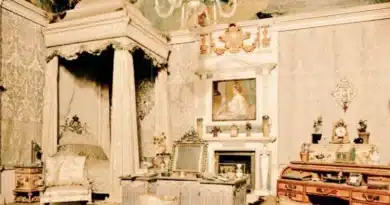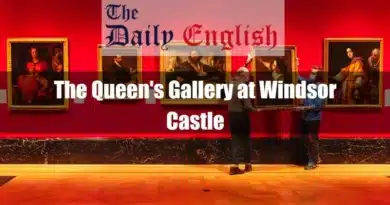The Semi-State Rooms, Windsor Castle
The Semi-State Rooms, Windsor Castle are a suite of private apartments created for King George IV in the 19th century. Located in the Upper Ward of the castle, these rooms were designed for the king’s personal use and for entertaining close friends and guests. They showcase opulent interiors with rich furnishings and elaborate decorations, reflecting George IV’s taste for luxury. Today, the Semi-State Rooms are open to the public during the winter months, offering visitors a glimpse into the private quarters of the royal residence.
Key Points
| Category | Key Information |
|---|---|
| History and Origin | A Historical Background of Windsor Castle – Century – 18th Century): – 1070s: William the Conqueror begins construction of a fortification on the site. – 12th—16th Centuries: Successive monarchs expand and transform the Castle, adding royal apartments, St. George’s Chapel, and a Great Hall. – 17th—18th Centuries: The Castle primarily serves as a hunting lodge, with some modernization efforts under Charles II. Development through Monarchic Eras: – Georgian Era (1714 – 1830): Renewed focus on Windsor Castle as a royal residence. – George III acquires Buckingham House and uses other residences like Kew Palace and Windsor Castle. – George IV embarks on a grand renovation project under architect Jeffry Wyatville. – Remodels the exterior for a more romantic aesthetic. – Commissions the creation of the Semi-State Rooms, a new suite of private apartments. Creation of the Semi-State Rooms (1820s): – Monarch: George IV – Architect: Sir Jeffry Wyatville – Significance: Represent George IV’s final and grandest interior design project. – Style: Influenced by Greek and Roman models, Regency style with exotic touches (Egyptian, Chinese motifs). |
| Architect and Designers | – Redesign overseen by Sir Jeffry Wyatville, a prominent architect of the Regency era. – Wyatville collaborated with skilled artisans and designers to bring George IV’s vision to life. |
| Location and Layout | – Located in the Upper Ward of Windsor Castle, adjacent to the State Apartments. – Served as a transition between the formal State Apartments and the monarch’s private quarters. |
| Key Rooms | – Crimson Drawing Room: Used for receptions and private gatherings, known for its red décor and opulent furnishings. – Green Drawing Room: Used for informal meetings, adorned with green silk walls and elegant furnishings. – Blue Drawing Room: Designed for relaxation and smaller gatherings, featuring a more subdued colour palette. – State Dining Room: Used for private dinners, a more intimate space than the larger State Apartments. |
| Architectural Style | – Regency style, characterised by symmetry, classical influences, and opulence. – Key elements: elaborate ceilings with gilded accents, rich fabrics (e.g., silk wall coverings), and fine furniture by renowned cabinetmakers (e.g., Morel and Seddon). |
| Artistic Treasures | – Houses an impressive collection of artwork, including portraits, landscapes, and decorative objects, many personally selected by George IV. |
| Preservation and Restoration | – Undergone careful preservation over the centuries. – Significant restoration work carried out after the 1992 fire at Windsor Castle. |
| Public Access | – Open to the public from October to March (winter months). – Coincides with the State Apartments being less frequently used for royal functions. |
| Visitor Experience | – Guided tours available, providing detailed insights into the rooms’ history, architecture, and design. – Highlights to look for: silk wall coverings in the Crimson Drawing Room, intricate plasterwork on the ceilings, and fine furniture. |
| Key FAQs Summary | – Why “Semi-State”? Distinguishes them from the more formal State Apartments; designed for private use. – Current Use: Primarily used by the Royal Family for private events. – Accessibility: Yes, but check in advance. – Photography: Typically, no. |
History and Origin

A Historical Background of Windsor Castle
Windsor Castle’s rich history provides context to the creation of the Semi-State Rooms. Let’s delve into its development through different eras.
Origins and Early Construction (11th Century – 18th Century)
- 1070s: William the Conqueror, following the Norman conquest of England, begins constructing a motte-and-bailey fortification on the site of what would become Windsor Castle.
- 12th—16th Centuries: Under successive monarchs, the Castle underwent significant expansion and transformation. Henry II established a stone keep, and later monarchs like Henry III and Edward III added royal apartments, a chapel (St. George’s Chapel), and a Great Hall.
- 17th—18th Centuries: The Castle primarily served as a hunting lodge for the monarchs. However, Charles II undertook some modernisation efforts, including improvements to the State Apartments.
Development through Monarchic Eras
- Georgian Era (1714 – 1830): This period witnessed a renewed focus on Windsor Castle as a royal residence.
- George III acquired Buckingham House 1761 for Queen Charlotte and used other residences like Kew Palace and Windsor Castle.
- George IV embarked on a grand renovation project under architect Jeffry Wyatville. This included remodelling the Castle’s exterior for a more romantic aesthetic and commissioning the creation of a new suite of private rooms on the sunnier east side: The Semi-State Rooms.
Creation of the Semi-State Rooms (1820s)
- Monarch: George IV
- Architect: Sir Jeffry Wyatville
- Significance: These rooms represent George IV’s final and grandest interior design project.
- Style: The design of the Semi-State Rooms was influenced by Greek and Roman models and the Regency style popular in the early 19th century, which included some exotic touches such as Egyptian and Chinese motifs.
Later Developments and Challenges
- 19th Century: The Semi-State Rooms became a favoured space for the British Royal Family to entertain guests.
- 1992: During the fire in 1992, efforts were made to save as many contents as possible from the Semi-State Rooms, although not all could be removed before the fire caused significant damage.
- Restoration: Following the fire, a careful restoration effort ensured the rooms were returned to their original 19th-century glory using original design plans.
Layout and Features

The Location within Windsor Castle
The Semi-State Rooms are located in the Upper Ward of Windsor Castle, adjacent to the State Apartments. This positioning allowed them to serve as a transition between the more formal State Apartments and the private quarters of the monarch.
Key Rooms in the Suite
The Semi-State Rooms include several notable spaces, each with its own unique features and purpose:
- The Crimson Drawing Room: Known for its rich red décor and opulent furnishings, this room served as a reception area for private audiences and gatherings.
- The Green Drawing Room: Adorned with green silk walls and elegant furnishings, this room was often used for informal meetings.
- The Blue Drawing Room: Featuring a more subdued colour palette, this room was designed for relaxation and smaller gatherings.
- The State Dining Room: A more intimate dining space than the larger State Apartments, this room was used to host private dinners.
Architectural and Design Highlights

Regency Style Elegance
The Semi-State Rooms are a testament to the Regency style, characterized by symmetry, classical influences, and opulence. Key elements include:
- Elaborate Ceilings: Many rooms feature intricately plastered ceilings with gilded accents.
- Rich Fabrics: Silk wall coverings and heavy draperies enhance the luxurious ambience.
- Fine Furniture: Pieces crafted by renowned cabinetmakers of the era, such as Morel and Seddon, are prominently displayed.
Artistic Treasures
The rooms also house an impressive collection of artwork, including portraits of notable figures, landscapes, and decorative objects. Many pieces were personally selected by George IV and remain integral to the rooms’ décor.
The Semi-State Rooms Today
Preservation and Restoration
Over the centuries, the Semi-State Rooms have undergone careful preservation to maintain their historical integrity. Following the devastating fire at Windsor Castle in 1992, significant restoration work was carried out to repair and restore these rooms to their former glory.
Public Access
The Semi-State Rooms are open to the public from October to March each year, coinciding with the closure of the State Apartments for royal use. This seasonal access offers visitors a rare opportunity to explore these private spaces and learn about their history and significance.
Visitor Experience

Guided Tours
Visitors to the Semi-State Rooms can enjoy guided tours that provide detailed insights into these spaces’ history, architecture, and design. Knowledgeable guides share stories about the rooms’ creation, their use by various monarchs, and the artisans who contributed to their grandeur.
Highlights to Look For
Some key features to observe during a visit include:
- The stunning silk wall coverings in the Crimson Drawing Room.
- The intricate plasterwork on the ceilings showcased the Regency era’s craftsmanship.
- The array of fine furniture and decorative arts exemplify George IV’s refined taste.
Conclusion
The Semi-State Rooms at Windsor Castle offer a captivating blend of history, art, and architecture. They stand as a testament to King George IV’s vision and the skill of the artisans who brought his dream to life. For visitors, these rooms provide an unparalleled glimpse into the private world of the monarchy, making them a must-see attraction for anyone interested in British history and royal heritage.
FAQs on the Semi-State Rooms at Windsor Castle
Why are they called the Semi-State Rooms?
The term “Semi-State” distinguishes these rooms from the more formal State Apartments. The Semi-State Rooms were designed for private use by the monarch and close associates, offering a blend of grandeur and intimacy.
Who uses the Semi-State Rooms today?
The Semi-State Rooms are primarily used by the Royal Family for private events, receptions, and official functions when the State Apartments are unavailable or unsuitable.
Are the Semi-State Rooms accessible to people with disabilities?
Yes, Windsor Castle provides accessibility options for visitors with disabilities. However, it’s advisable to check in advance for specific accommodations related to the Semi-State Rooms, as some areas of the castle may have limited access due to its historic nature.
What specific events have taken place in the Semi-State Rooms?
While the article mentions their use for private functions, notable events such as receptions for international dignitaries, royal family gatherings, and select ceremonial occasions have also occurred in the Semi-State Rooms.
How do the Semi-State Rooms compare to the State Apartments in terms of design and function?
While the State Apartments are more formal and used for large-scale ceremonial events, the Semi-State Rooms are smaller, more intimate, and reflect a personalized touch aligned with George IV\u2019s tastes.
What changes were made to the Semi-State Rooms after George IV?
Subsequent monarchs made modifications to adapt the rooms for their own use. However, much of the original design by George IV has been preserved or restored.
Why are the Semi-State Rooms only open in winter?
The Semi-State Rooms are open to the public during the winter months (October to March) because the State Apartments, which host major royal functions, are less frequently used during this period. This scheduling allows for maintenance and preparation in other areas of the castle.
Are there guided tours specific to the Semi-State Rooms?
Yes, while general tours of Windsor Castle include the Semi-State Rooms, some specialized tours may provide in-depth information on their history, design, and restoration.
Can photographs be taken inside the Semi-State Rooms?
Photography is typically prohibited inside the Semi-State Rooms to protect the delicate furnishings and artworks.
How do the Semi-State Rooms reflect George IV\u2019s personality?
The rooms showcase George IV\u2019s love for opulence, with intricate designs, luxurious fabrics, and an emphasis on Regency-era aesthetics, offering insights into his vision of royal grandeur.
What role did the Semi-State Rooms play during the 1992 fire at Windsor Castle?
The Semi-State Rooms were affected by the fire but were not as heavily damaged as other parts of the castle. Restoration efforts included carefully preserving the original designs while incorporating modern fireproofing measures.
What are some hidden details or lesser-known features of the Semi-State Rooms?
The Semi-State Rooms feature hidden doorways, concealed storage areas, and symbolic motifs in the d\u00e9cor that reflect George IV\u2019s personal interests and the artisanship of the Regency period.
Are there any royal portraits or significant artworks exclusive to the Semi-State Rooms?
Yes, the Semi-State Rooms house several exclusive portraits and artworks, including pieces commissioned by George IV and others gifted to the Royal Family. These include works by prominent artists of the 19th century.
Do the Semi-State Rooms serve any ceremonial purpose today?
While their primary use is private, the rooms occasionally host smaller, intimate ceremonies or receptions that align with royal traditions.
What materials were used to restore the Semi-State Rooms after the fire?
Authentic materials, such as silk wall coverings, gold leaf, and Regency-style furniture replicas, were used to restore the Semi-State Rooms to their original splendour following the fire.
Can the Semi-State Rooms be rented or used for private events by the public?
No, the Semi-State Rooms are strictly reserved for use by the Royal Family and are not available for public rental or private events.
Are there any interactive exhibits related to the Semi-State Rooms?
Some exhibitions and displays at Windsor Castle provide interactive insights into the history and restoration of the Semi-State Rooms, but these are separate from the rooms themselves.
How do the Semi-State Rooms differ from private apartments in other royal residences?
The Semi-State Rooms are unique to Windsor Castle and reflect the specific tastes of George IV, unlike the private apartments in Buckingham Palace or other royal residences, which are tailored to different monarchs and eras.
What conservation measures are in place to preserve the Semi-State Rooms?
The Royal Collection Trust implements strict conservation protocols, including controlled lighting, humidity, and temperature settings, to protect the Semi-State Rooms’ delicate furnishings and artworks.
What makes the Semi-State Rooms a must-visit for history enthusiasts?
The Semi-State Rooms offer a rare glimpse into the Regency period and the personal world of King George IV, showcasing how royalty lived and entertained in a blend of luxury and privacy.









